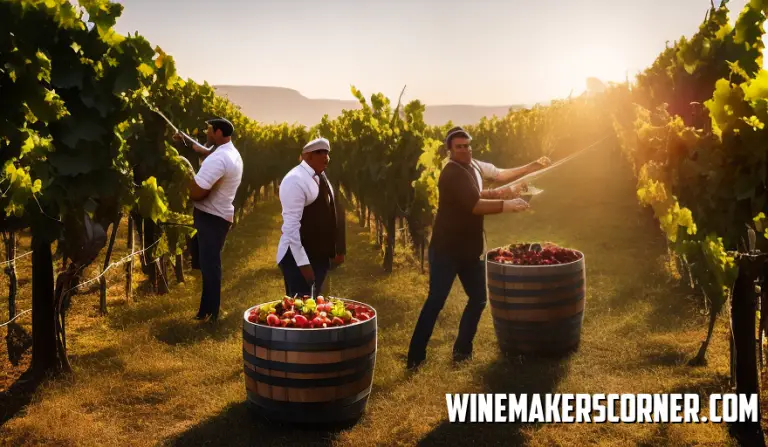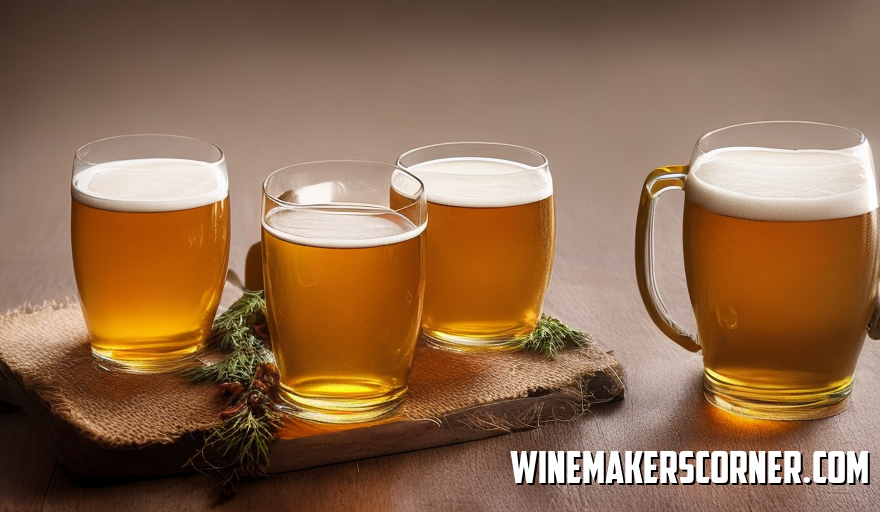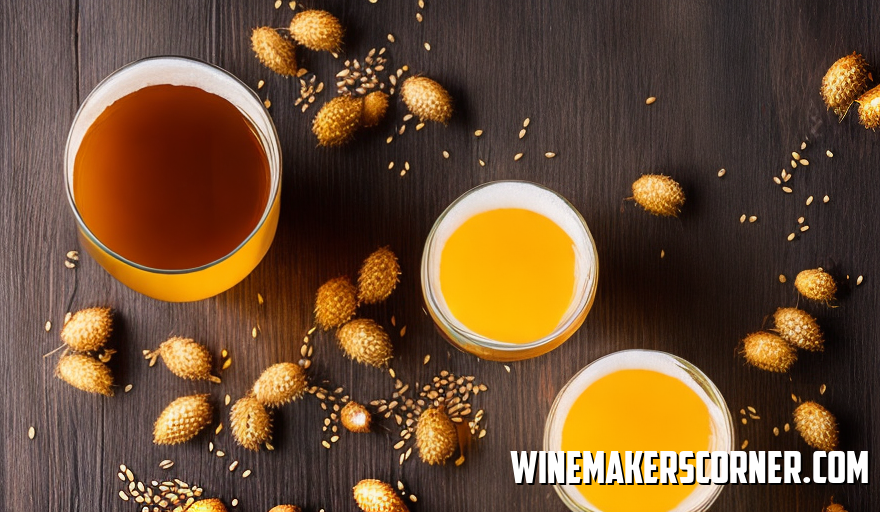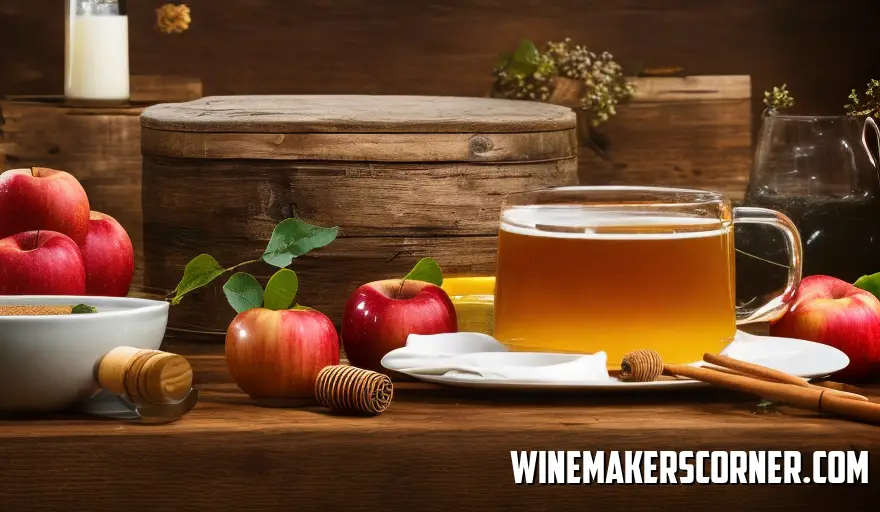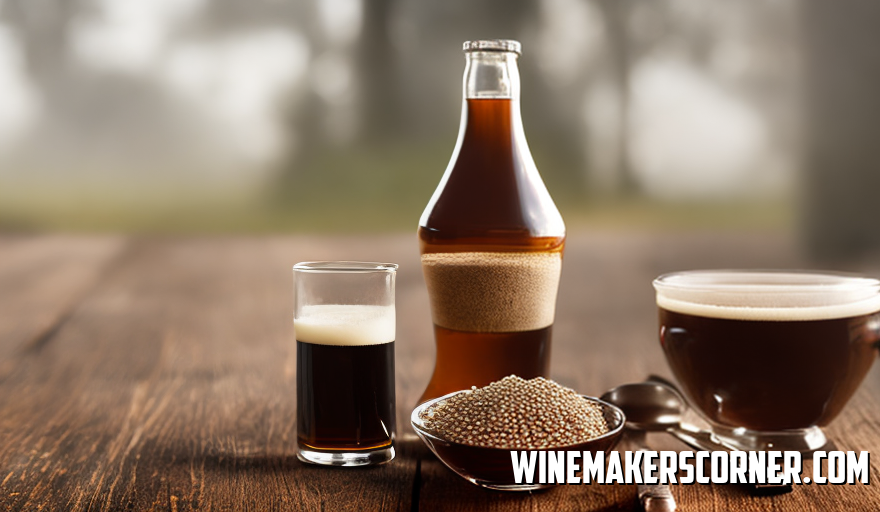As the sun sets below the horizon casting an array of orange and pink across the sky imagine yourself in a picturesque vineyard in Tuscany. You hold a glass of ruby red wine taking in its enticing aroma as it reaches your nose. The first sip explodes with flavors on your taste buds. It’s fruity, absolutely divine. This isn’t your wine; it’s a delightful fusion of fruits that create a symphony of tastes dancing on your palate.
Greetings to all wine enthusiasts there! Are you ready for a culinary journey? An exploration that goes beyond the use of grapes and reinvents the timeless art of winemaking? Wonderful! Because today we will delve into the captivating world of crafting wines by infusing them with fruits turning them into something truly exceptional.
We will immerse ourselves in the secrets and wonders of winemaking while dispelling any misconceptions along the way. We’ll discuss fruits. Their role in wine production how to carefully select them find the perfect balance for their flavors and expertly infuse them into our beloved beverages. We’ll also touch upon sugars and fermentation processes.
So grab yourself a glass of your drink and get ready for an enlightening voyage through vineyards abundant with more, than just grapes. Cheers!
Understanding the Role of Fruits in Wine Making
Winemaking is truly an art form that involves the transformation of fruit into a delightful beverage. While grapes are the choice there are numerous other fruits that can bring unique and thrilling flavors to wine. The role these fruits play in winemaking is both fascinating and multifaceted.
Lets consider the apple, which has become more than a staple for cider. Apples have the ability to contribute an acidity to wine perfectly balancing out sweeter notes. Different apple varieties offer variations in flavor profiles; for instance you have the tartness of Granny Smiths contrasting beautifully with the sweetness of Honeycrisps.
Then there’s the peach—a stone fruit that captures the essence of summer like no other. Peach wine can be a revelation bursting with vibrant and sun ripened flavors. It possesses a intricate nature that truly reflects its origins.
Berries also hold a place in winemaking traditions. We shouldn’t limit ourselves to grapes raspberries, blackberries and even elderberries offer incredible flavor intensity that can elevate any wine.
Adding fruit to a wine recipe serves a purpose beyond simply increasing sweetness—though it certainly accomplishes that too! It’s about layering flavors. Creating depth in each sip. More fruit translates into complexity with each type contributing its own distinctive character.
However it’s important to remember one thing; balance is absolutely crucial, in winemaking well as life itself.
Excessive amounts of any element can disrupt the balance and ultimately make the final product less enjoyable.
To sum up fruits have an impact, on the flavor profile of wine. Trying out types can yield unexpected and delightful outcomes! Feel free to incorporate fruits into your upcoming wine recipe!
Selecting the Right Fruits for Your Wine
Choosing the fruits for your wine is truly an art. It’s not a matter of picking any fruit; it’s about understanding the distinct qualities that each one brings to your drink.
Lets consider this; apples are known for their fresh nature. They add an refreshing touch to wines but they may not be the ideal choice if you desire a full bodied and robust flavor.
On the hand berries such as blackberries or raspberries offer a delightful intensity. They burst with flavors that can bring depth to your wine recipe. However it’s important to use them in moderation as their strong taste might overpower delicate flavors.
Exploring the allure of fruits like mangoes or pineapples can be quite intriguing. They infuse wines with notes and a unique sweetness that many people enjoy. Nevertheless keep in mind that their high sugar content could result in wines that’re too sweet for certain palates.
Finding balance is crucial here. Combining fruits can create wonderfully complex wines with layers of flavor. How about blending strawberries with peaches? The tartness of strawberries could beautifully complement the sweetness of peaches.
Lastly lets touch upon the debate, between using dried fruits in winemaking…Fresh fruits provide a burst of lively flavors whereas dried fruits offer concentrated tastes and the possibility of higher alcohol content due to their increased sugar levels.
In the end choosing the fruit involves comprehending how each type enhances your wine recipe – factors such, as flavor profile, sugar levels, acidity and even color all play a vital role when incorporating more fruit into a wine recipe.
The Art of Balancing Fruit Flavors in Wine
Wine is like an art form, a delicate dance of flavors. It’s not about the grapes themselves. Incorporating fruits into a wine recipe can take it to new levels of delight. However it’s not as simple as throwing in some fruit and stirring it up. The key lies in finding the balance.
Imagine taking a bite of a ripe peach and experiencing its sweet explosion in your mouth. Now picture savoring the crispness of a green apple. Both are sensations but would you really want your wine to taste solely like peaches or apples? Likely not.
In the world of winemaking fruits add complexity and depth to the flavor profile. They introduce layers of taste. Sweetness, sourness, bitterness and more.. Here’s the tricky part. Adding too much fruit can overpower the delicate nature of the wine itself.
This is where true artistry comes into play. A touch of strawberry here or a hint of blackberry there. These subtle additions can enhance the character of the wine without overwhelming it.
Let me give you an example; A Merlot infused with raspberries could be absolutely divine. If you go overboard with too many raspberries you run the risk of losing that distinct richness that makes Merlot so special. The ultimate goal is achieving harmony between grape flavors and fruit flavors.
Now lets talk about acidity. Another factor when incorporating fruits into wines. Fruits, like lemons or pineapples bring levels of acidity which if not balanced correctly can make your wine taste sharp or overly tangy.
So how can we achieve this balance? It involves a combination of trial and error and a deep understanding of the ingredients involved.
When it comes to selecting the fruits for each type of wine knowledge is essential. It’s important to understand how each fruit behaves during the fermentation process and how its flavor develops over time. This journey of exploring possibilities is quite thrilling!
In summary incorporating fruit into your wine recipe isn’t as straightforward as it may appear. However when done correctly it opens up a new world of delightful possibilities! Always remember that finding the balance is key, to successful winemaking. Enjoy your winemaking endeavors!
Techniques for Infusing More Fruit into Your Wine
Adding fruit to your wine can be an exciting experiment. It has the potential to enhance the flavor, color and aroma of your concoction. Fortunately it’s not as complicated as it may appear. However there are some techniques that you should master.
To begin with carefully consider the type of fruit you wish to incorporate. Different fruits can significantly impact the profile of your wine. Opting for fruits with flavors such as berries, cherries or peaches is a wise choice. Both fresh and dried fruits can work wonders.
The next step revolves around timing. When is the best moment to introduce the fruit? Many experienced winemakers recommend adding it during the secondary fermentation process. This technique helps preserve more of the fruits flavors and aromas in the final product.
Lets now discuss quantities. How fruit should you use? As a guideline aim for one to three pounds of fruit per gallon of wine. However keep in mind that this can vary depending on how prominent you want the fruity notes to be in your wine.
Remember that simply tossing fruits into your mixture won’t suffice! Properly preparing them is crucial, for an infusion. It’s important to crush or chop the fruits into pieces before incorporating them.
Lastly but not least ensuring sanitation is paramount! It cannot be emphasized enough how important it is to maintain cleanliness throughout every step of the process.
Make sure to clean and sterilize all the equipment you’ll be using before embarking on your wine journey.
To sum up adding fruit flavor to your wine requires careful selection, precise timing and preparation techniques as well, as maintaining proper hygiene practices.
How to Adjust Sugar Levels When Adding More Fruits
The craft of crafting wine requires an equilibrium. When you choose to incorporate fruit into your wine recipe it’s not just about enhancing the flavor. There’s another factor to consider – the sugar levels. Fruits naturally contain sugar. This can have a significant impact on the fermentation process and the final taste of your wine.
Increasing the amount of fruit translates to an increase in sugar content. While this may seem appealing excessive amounts can result in an alcoholic or even spoiled wine. So how do you achieve that extra fruity kick without turning your wine into a disaster?
Firstly it’s important to familiarize yourself with fruits and their respective sugar contents. For instance bananas are rich in sugars while berries tend to have lower levels. If you plan on using a combination of fruits calculate their combined sugar content.
Once you have an idea of the sugar content from your added fruit make adjustments to sources of sweetness in your recipe accordingly. You may need to reduce or even eliminate sugar if your fruit is exceptionally sweet.
However lets not forget that wine isn’t about sweetness; it also relies on balance. While reducing added sugars helps control alcohol levels excessive reduction can lead to an overemphasis, on acidity if not carefully monitored.
Testing plays a role, in this process. You can utilize a hydrometer or refractometer to determine the gravity of the must before fermentation begins. This measurement will indicate whether there is sugar for the yeast to ferment.
It’s important to remember that winemaking is a combination of science and art requiring both precision and creativity. Feel free to explore fruits and make adjustments until you find the ideal blend that satisfies your taste!
Impact of Additional Fruits on Fermentation Process
When you add fruit to a wine recipe it can have a significant impact on the fermentation process and the final product. This impact is diverse affecting the taste, smell, color and even the nutritional value of the wine.
The addition of fruit directly affects the sugar content. When you add fruit it means there are more natural sugars for yeast to feed on during fermentation. If all the sugar ferments this could potentially result in an alcohol content.
However not all fruits have the amount of sugar or acidity levels. For example berries have acidity but relatively low sugar compared to grapes. Therefore incorporating fruits may affect how sweet or tart your wine tastes.
Furthermore when you add fruits to your wine recipe they introduce flavors and aromas that can either enhance or clash with your base wine. The key is to choose fruits that blend well with your primary grape variety.
It’s important to remember that each fruit has its unique enzymes and microorganisms. These can influence how fermentation occurs by introducing metabolic pathways or causing variations in fermentation rates.
Lastly lets not forget about the aspect of your wine. Fruits contribute their colors during maceration – think of blush rosé from red grapes or rich ruby port, from blackberries.
In summary incorporating fruits into your wine recipe goes beyond enhancing flavors. It involves a nuanced combination of chemistry and artistic expression that can result in a homemade bottle of wine.
Pairing Additional Fruits with Different Types of Wines
Pairing types of fruits with wine? It’s such a subject. I’m not just talking about adding a lemon slice to your Chardonnay. It goes beyond that and it can be quite a delightful experience.
Lets begin with wines. They are light, refreshing, with hints of citrus and they go well with various fruits. Imagine enjoying a Sauvignon Blanc alongside grapefruit or kiwi. The tartness of the fruit beautifully balances the wines acidity.
When it comes to wines we need to approach it differently. The robust flavors of wines call for fruits that can hold their ground without being overshadowed. Think about pairing blackberries, cherries or plums with wine. These rich and deep fruits complement the tannins in wine perfectly.
Now lets shift our focus to rosé wines. They are incredibly versatile. Can be paired with a variety of fruits depending on their sweetness levels. Dry rosés work well with strawberries and raspberries while sweeter varieties pair nicely with peaches or melons.
Here’s where the real magic happens – when you start exploring beyond these basic pairings! Have you ever considered pairing pomegranate with Pinot Noir?. How about pineapple alongside a sparkling Prosecco? The possibilities are truly endless and filled with excitement.
Remember – there are no rules that apply universally here! Pairing wine and fruit is an art form, than an exact science. It requires creativity and a willingness to experiment until you find your combination.
In summary adding fruit to your wine recipe is definitely recommended. It enhances the taste experience brings depth to the flavors and transforms every sip into a delightful journey, for your palate.
